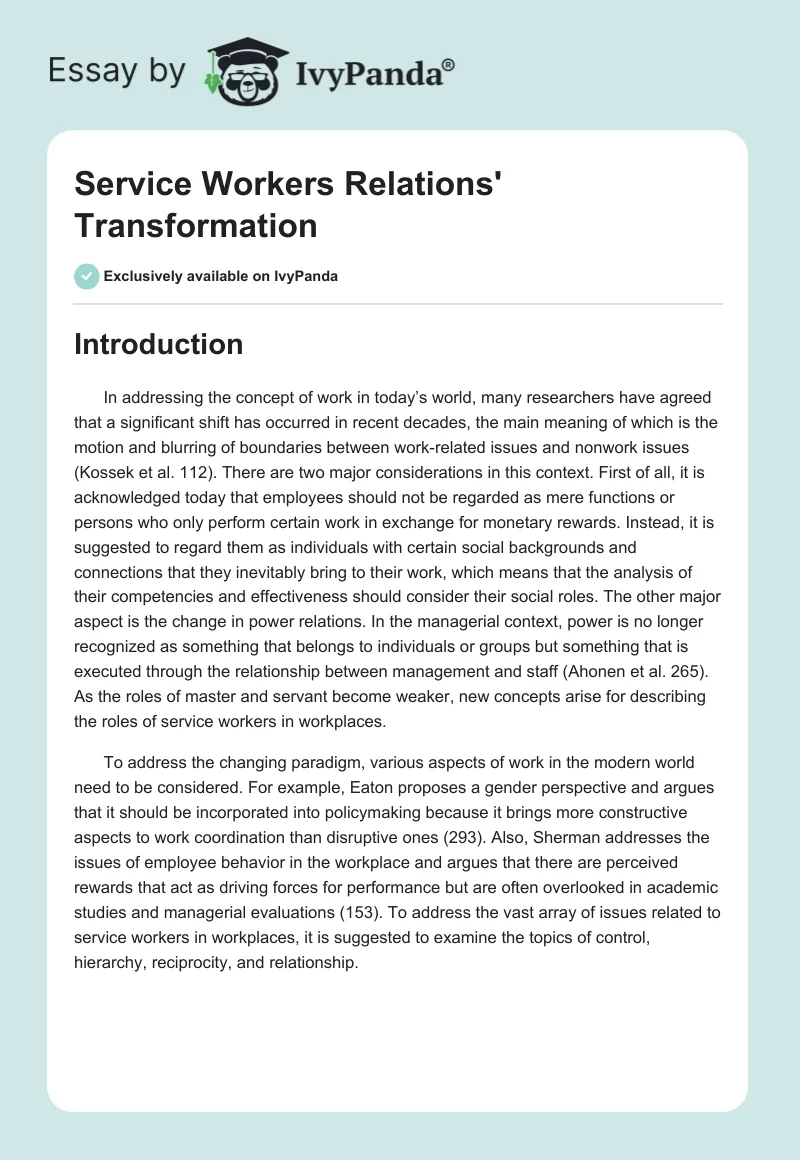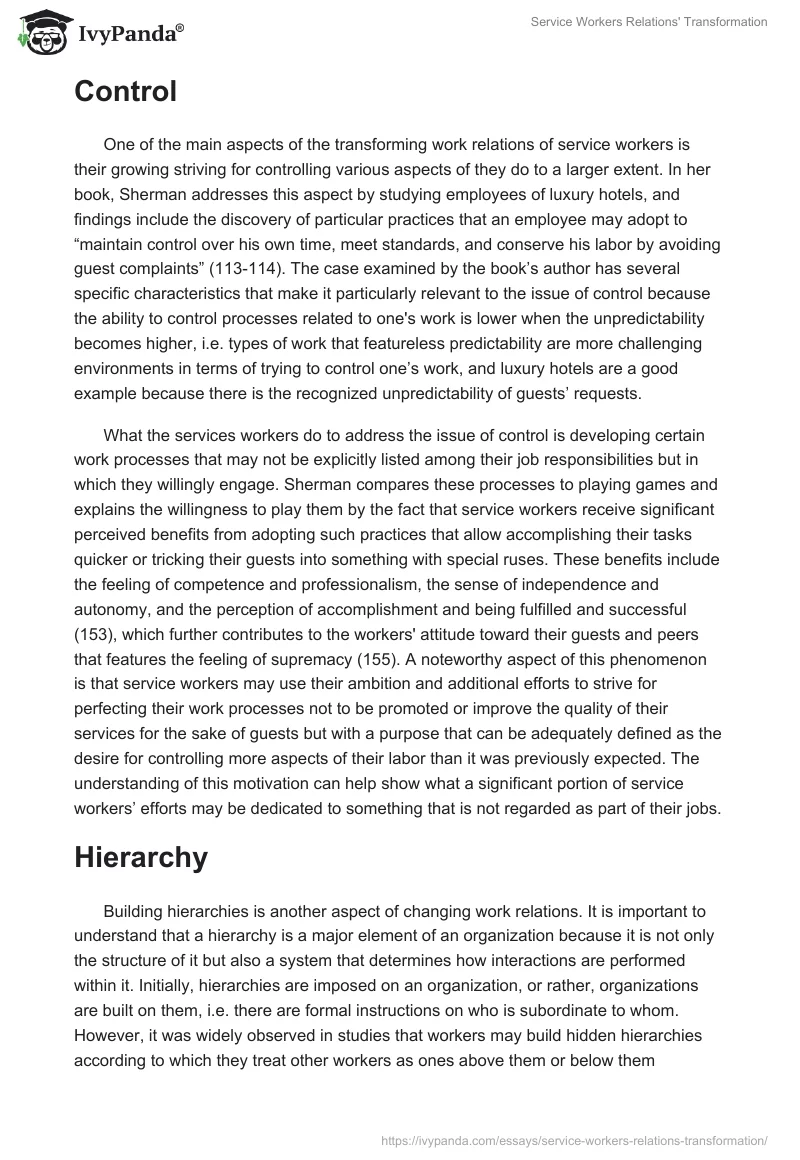Introduction
In addressing the concept of work in today’s world, many researchers have agreed that a significant shift has occurred in recent decades, the main meaning of which is the motion and blurring of boundaries between work-related issues and nonwork issues (Kossek et al. 112). There are two major considerations in this context. First of all, it is acknowledged today that employees should not be regarded as mere functions or persons who only perform certain work in exchange for monetary rewards. Instead, it is suggested to regard them as individuals with certain social backgrounds and connections that they inevitably bring to their work, which means that the analysis of their competencies and effectiveness should consider their social roles. The other major aspect is the change in power relations. In the managerial context, power is no longer recognized as something that belongs to individuals or groups but something that is executed through the relationship between management and staff (Ahonen et al. 265). As the roles of master and servant become weaker, new concepts arise for describing the roles of service workers in workplaces.
To address the changing paradigm, various aspects of work in the modern world need to be considered. For example, Eaton proposes a gender perspective and argues that it should be incorporated into policymaking because it brings more constructive aspects to work coordination than disruptive ones (293). Also, Sherman addresses the issues of employee behavior in the workplace and argues that there are perceived rewards that act as driving forces for performance but are often overlooked in academic studies and managerial evaluations (153). To address the vast array of issues related to service workers in workplaces, it is suggested to examine the topics of control, hierarchy, reciprocity, and relationship.
Control
One of the main aspects of the transforming work relations of service workers is their growing striving for controlling various aspects of they do to a larger extent. In her book, Sherman addresses this aspect by studying employees of luxury hotels, and findings include the discovery of particular practices that an employee may adopt to “maintain control over his own time, meet standards, and conserve his labor by avoiding guest complaints” (113-114). The case examined by the book’s author has several specific characteristics that make it particularly relevant to the issue of control because the ability to control processes related to one’s work is lower when the unpredictability becomes higher, i.e. types of work that featureless predictability are more challenging environments in terms of trying to control one’s work, and luxury hotels are a good example because there is the recognized unpredictability of guests’ requests.
What the services workers do to address the issue of control is developing certain work processes that may not be explicitly listed among their job responsibilities but in which they willingly engage. Sherman compares these processes to playing games and explains the willingness to play them by the fact that service workers receive significant perceived benefits from adopting such practices that allow accomplishing their tasks quicker or tricking their guests into something with special ruses. These benefits include the feeling of competence and professionalism, the sense of independence and autonomy, and the perception of accomplishment and being fulfilled and successful (153), which further contributes to the workers’ attitude toward their guests and peers that features the feeling of supremacy (155). A noteworthy aspect of this phenomenon is that service workers may use their ambition and additional efforts to strive for perfecting their work processes not to be promoted or improve the quality of their services for the sake of guests but with a purpose that can be adequately defined as the desire for controlling more aspects of their labor than it was previously expected. The understanding of this motivation can help show what a significant portion of service workers’ efforts may be dedicated to something that is not regarded as part of their jobs.
Hierarchy
Building hierarchies is another aspect of changing work relations. It is important to understand that a hierarchy is a major element of an organization because it is not only the structure of it but also a system that determines how interactions are performed within it. Initially, hierarchies are imposed on an organization, or rather, organizations are built on them, i.e. there are formal instructions on who is subordinate to whom. However, it was widely observed in studies that workers may build hidden hierarchies according to which they treat other workers as ones above them or below them although these positions do not necessarily match the official distribution of roles (Sherman 175-176). This phenomenon is connected to the enhanced understanding of power as something that occurs among people as opposed to something that belongs to certain individuals or groups (Ahonen et al. 265). Service workers are especially likely to engage in building these hierarchies because they contemporarily tend to develop a growing appreciation of their labor, which allows them to place themselves above their peers and even express condescension to their clients.
Not only should the process of building informal hierarchies be addressed but also the processes that oppose the hierarchical operation of organizations. These processes constitute the horizontal cooperation among employees that is inherently resistant to the verticality of management systems. An example of these processes is unionization. Eaton addresses this subject and states that the essence of these horizontal developments is creating conditions under which “employee input and involvement” (316) are enabled. In a sense, this is a continuation of the control theme, as there is the service workers’ intention and striving for having more impact on their work. Instead of being parts of hierarchies where everyone has a strictly determined role, as in links of a chain, workers confront hierarchies with their form of organization that gives them more power. This democratization of work relations with the growing importance of extensive cooperation on different levels and the decreasing importance of regulations from above is a major characteristic of the hierarchy-related shift.
Relationships and Reciprocity
The trends outlined above show how service workers are moving toward the discontinuation of regarding themselves and being regarded as functions and toward a sort of empowerment. Major characteristics of this empowerment noted by researchers are building relationships and eliciting reciprocity. Eaton provides several examples of work renegotiations on the workplace basis and shows how unequal power relationships can be modified using what she refers to as “jointness” (306). However, this rather refers to the relationships between employees and employers, while the context of reciprocity more commonly applies to the relationships between service workers and clients. From this perspective, Sherman claims that, in the two luxury hotels where she observed service workers, “reciprocity was the key mechanism regulating worker-guest interactions” (185). Clients were much friendlier toward workers than it could have been expected, which was one of the main factors in the workers’ relationship building.
It indicates that service workers in the given examples came to regard relationship building as not a process where they solely, unilaterally apply efforts but as a process that requires a significant contribution from the people with which they communicate. Once again, this vision of reciprocity as a consideration of growing importance is linked to the spreading understanding that a service worker does not merely input something, i.e. works according to a certain list of tasks, but participates in interactions, which is a more complicated model of service work but, at the same time, a more insightful one, as it allows examining workplace-based initiatives and activities with a better understanding of worker’s motivations and perceived roles.
Conclusion
In the modern world, workplaces witness a transformation of service work. It is part of a more comprehensive process of change in global concepts and patterns of labor (Reeves and Read 6), but it is a complicated phenomenon in itself with a variety of interconnected elements. In this context, three particular characteristics of service work and workplace processes are growing efforts in gaining control over how work is done, redefining and revisiting hierarchies, and eliciting reciprocity in relationship building. Understanding all these processes is necessary for the creation of more successful human resources management strategies that will not regard workers as mere functions but will manage to grasp and take into account different motivations of service workers that have been previously overlooked in theoretical models and real-life policymaking.
Works Cited
Ahonen, Pasi, et al. “Hidden Contexts and Invisible Power Relations: A Foucauldian Reading of Diversity Research.” Human Relations, vol. 67, no. 3, pp. 263-286.
Eaton, Susan. “‘The Customer is Always Interesting’: Unionized Harvard Clericals Renegotiate Work Relationships.” Working in the Service Society, edited by Cameron Lynne Macdonald and Carmen Sirianni, Temple University Press, 1996, pp. 291-332.
Kossek, Ellen Ernst, et al. “Work-Nonwork Boundary Management Profiles: A Person-Centered Approach.” Journal of Vocational Behavior, vol. 81, no. 1, 2012, pp. 112-128.
Reeves, Byron, and J. Leighton Read. Total Engagement: How Games and Virtual Worlds Are Changing the Way People Work and Businesses Compete. Harvard Business Press, 2013.
Sherman, Rachel. Class Acts: Service and Inequality in Luxury Hotels. University of California Press, 2007.


